
The Good Conduct Medal is one of the oldest military awards of the United States Armed Forces. The U.S. Navy's variant of the Good Conduct Medal was established in 1869, the Marine Corps version in 1896, the Coast Guard version in 1923, the Army version in 1941, and the Air Force version in 1963; the Air Force Good Conduct Medal was temporarily discontinued from February 2006 to February 2009, followed by its subsequent reinstatement.
The Canadian Forces' Decoration is a Canadian award bestowed upon members of the Canadian Armed Forces who have completed twelve years of military service, with certain conditions. By convention, it is also given to the Governor General of Canada upon his or her appointment as viceroy, which includes the title of Commander-in-Chief in and over Canada. The decoration is awarded to all ranks, who must have a good record of conduct during the final eight years of claimed service.
The following is the Canadian order of precedence for decorations and medals. Where applicable, post-nominal letters are indicated.
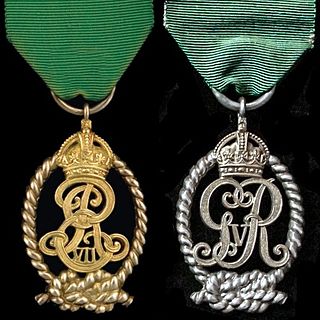
The Decoration for Officers of the Royal Naval Volunteer Reserve, post-nominal letters VD until c. 1947 and VRD thereafter, was instituted in 1908. It could be awarded to part-time commissioned officers in the United Kingdom's Royal Naval Volunteer Reserve after twenty years of service as efficient and thoroughly capable officers. The decoration was a Naval version of the Volunteer Officers' Decoration and its successor, the Territorial Decoration.
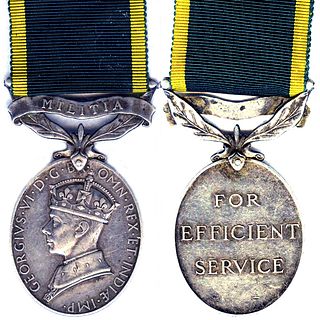
The Efficiency Medal was instituted in 1930 for award to part-time warrant officers, non-commissioned officers and men after twelve years of efficient service on the active list of the Militia or the Territorial Army of the United Kingdom, or of the other Auxiliary Military Forces throughout the British Empire. At the same time a clasp was instituted for award to holders of the medal upon completion of further periods of six years of efficient service.
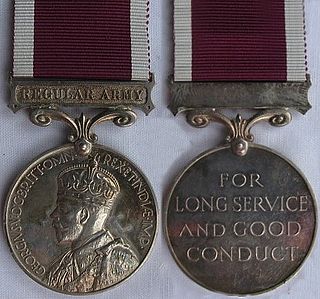
The Medal for Long Service and Good Conduct (Military) is a medal awarded to regular members of the armed forces. It was instituted by King George V in 1930 and replaced the Army Long Service and Good Conduct Medal as well as the Permanent Forces of the Empire Beyond the Seas Medal. The medal was originally awarded to Regular Army warrant officers, non-commissioned officers and men of the UK Armed Forces. It also had a number of territorial versions for the Permanent Forces of the British Dominions. The eligibility criteria were relaxed in 1947 to also allow the award of the medal to officers who had served a minimum period in the ranks before being commissioned. Since 2016, the eligibility was widened to include officers who had never served in the ranks, and so the medal can now be awarded to all regular members of the British Army who meet the required length of service.
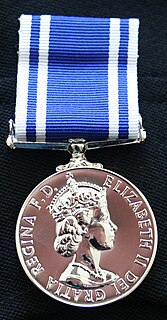
The Police Long Service and Good Conduct Medal is a decoration for police officers of the United Kingdom. First instituted in 1951, the medal is presented for twenty aggregate years of service in the police services of the United Kingdom.

The National Crime Agency (NCA) is a national law enforcement agency in the United Kingdom. It is the UK's lead agency against organised crime; human, weapon and drug trafficking; cybercrime; and economic crime that goes across regional and international borders; but it can be tasked to investigate any crime. The NCA has a strategic role in which it looks at the bigger picture across the UK, analysing how criminals are operating and how they can be disrupted. To do this, it works closely with regional organised crime units (ROCUs), local police forces, and other government departments and agencies.
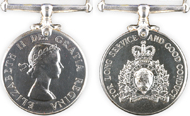
The Royal Canadian Mounted Police Long Service Medal was established by royal warrant on 6 March 1934 by King George V. It is the oldest continually awarded honour within the Canadian honours system, and the first created specifically for Canadian service within Canada. Initially proposed by the Royal North-West Mounted Police Veterans’ Association, it took more than ten years for the proposal to be realized. The determination of the veterans was aided by the interest of Commissioner Cortlandt Starnes and Prime Minister R.B. Bennett.
The Long Service and Good Conduct Medal is a military award recognizing 15 years of exemplary and unblemished service by non-commissioned and other ranks members of the New Zealand Defence Force. Established in 1985, these medals replaced the British Long Service and Good Conduct Medals with specific versions for New Zealand. There are three version of the Long Service and Good Conduct Medal, one each for the New Zealand Army, Royal New Zealand Navy, and the Royal New Zealand Air Force.

The Ambulance Service Long Service and Good Conduct Medal is a long service medal of the United Kingdom established in 1995. The medal is awarded to recognise long service by all clinical grades of the ambulance services who serve on emergency duty.
The Medal for Long Service and Good Conduct was a long service medal of the United Kingdom, established in 1982. The medal was awarded to full-time members of the Ulster Defence Regiment upon the completion of 15 years of efficient service.
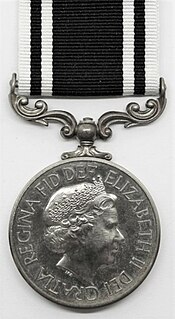
The Prison Services Long Service and Good Conduct Medal was established by Royal Warrant on 17 December 2010. The medal is awarded for long service to members of the various prison services of the United Kingdom.
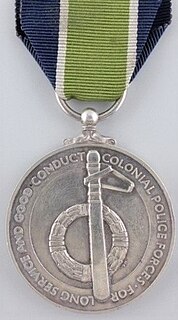
The Colonial Police Long Service Medal was established in 1934 to recognise long service in the police forces of the colonies and overseas territories of the United Kingdom. On 10 April 2012 the medal became known as the Overseas Territories Police Long Service Medal.

The Colonial Prison Service Medal was established on 28 October 1955 as a long service medal of the United Kingdom and the Commonwealth. On 10 April 2012 the medal became known as the Overseas Territories Prison Service Medal, and underwent a minor change in design. This reflected the change in the way Britain's remaining colonies were described, they having been classed as 'Overseas Territories' from 2002.

The Colonial Fire Brigades Long Service Medal, now known as the Overseas Territories Fire Brigades Long Service Medal, was established in 1934 to recognise long service in the fire services of the colonies and overseas territories of the United Kingdom.

The Naval Long Service and Good Conduct Medal (1848) is a long service medal awarded to regular members of Her Majesty's Naval Service. It was instituted by Queen Victoria to replace the Naval Long Service and Good Conduct Medal (1830), and could be awarded to other ranks and men serving in the Royal Navy and Royal Marines. Since 2016, after a number of changes in eligibility, all regular members of the Royal Navy and Royal Marines who have completed fifteen years of reckonable service can be awarded the medal.

The Royal Air Force Long Service and Good Conduct Medal is a medal awarded to regular members of the Royal Air Force in recognition of long service. It was instituted by King George V in 1919, the year following the establishment of the world's first independent air force. At first, the medal was awarded to Regular Force non-commissioned officers and airmen of the Royal Air Force. The award criteria were later relaxed to also allow the award of the medal to officers who had served a minimum period in the ranks before being commissioned. Since 2016, it is awarded to all regular members of the RAF, including officers who had never served in the ranks.

The Merchant Navy Medal for Meritorious Service is a state award within the British honours system. The medal is awarded to no more than 20 recipients annually who are announced on Merchant Navy Day, 3 September. A 'Merchant Navy Medal' with the same criteria was awarded by the Merchant Navy Welfare Board from 2005, before being superseded by the state award in 2015.

The Jersey Honorary Police Long Service and Good Conduct Medal is a decoration for members of the Honorary Police of the Bailiwick of Jersey. First instituted by Royal Warrant on 1 December 2014, it is an official award that can be worn alongside other British medals and decorations.
















